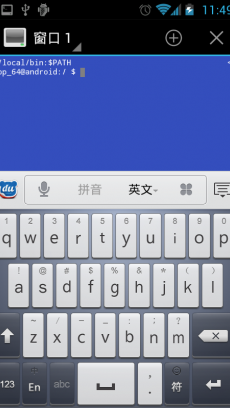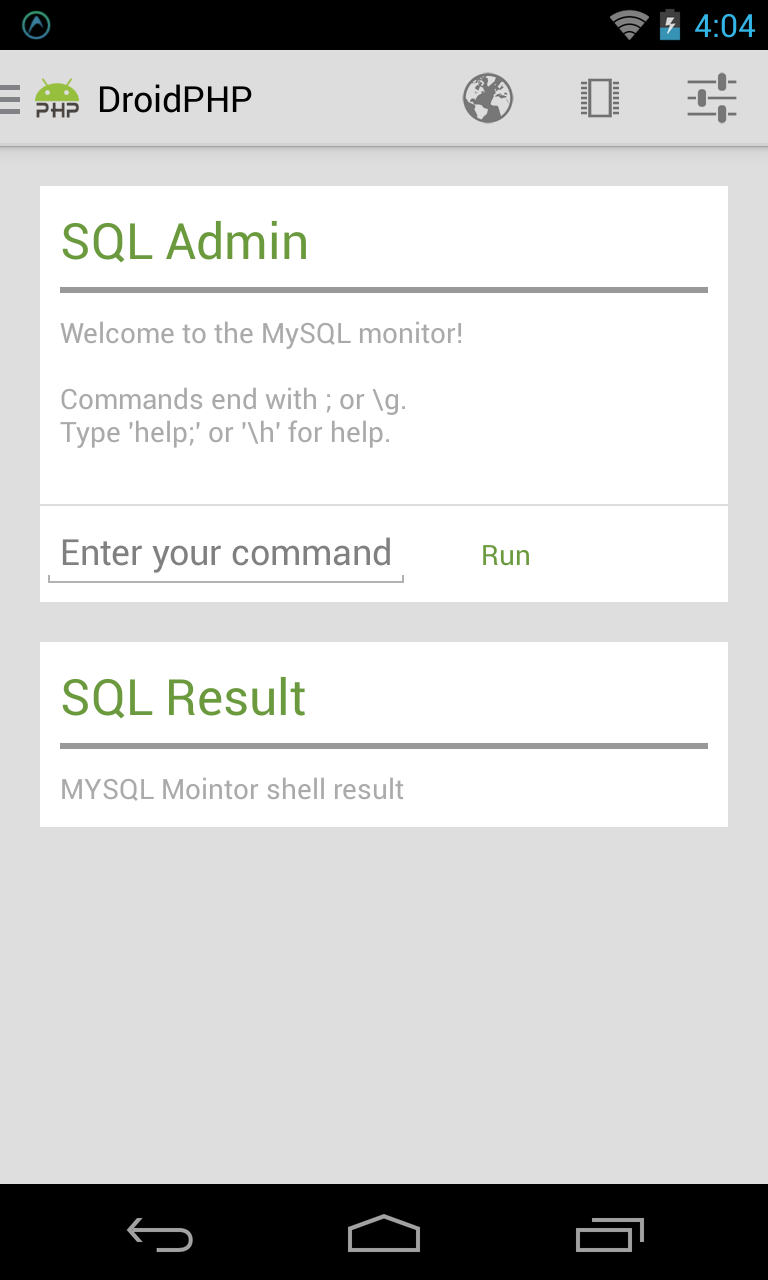Android wav录音示例代码下载
安卓后院(www.top139.com) 编辑:admin 时间:2016-08-12 15:25
Android wav录音示例代码下载:
package com.example.wavtest;
import java.io.File;
import java.io.FileInputStream;
import java.io.FileNotFoundException;
import java.io.FileOutputStream;
import java.io.IOException;
import android.app.Activity;
import android.media.AudioFormat;
import android.media.AudioRecord;
import android.media.MediaRecorder;
import android.os.Bundle;
import android.view.View;
import android.view.View.OnClickListener;
import android.widget.Button;
public class MainActivity extends Activity {
// 音频获取源
private int audioSource = MediaRecorder.AudioSource.MIC;
// 设置音频采样率,44100是目前的标准,但是某些设备仍然支持22050,16000,11025
private static int sampleRateInHz = 16000;
// 设置音频的录制的声道CHANNEL_IN_STEREO为双声道,CHANNEL_CONFIGURATION_MONO为单声道
private static int channelConfig = AudioFormat.CHANNEL_IN_MONO;
// 音频数据格式:PCM 16位每个样本。保证设备支持。PCM 8位每个样本。不一定能得到设备支持。
private static int audioFormat = AudioFormat.ENCODING_PCM_16BIT;
// 缓冲区字节大小
private int bufferSizeInBytes = 0;
private AudioRecord audioRecord;
private boolean isRecord = false;// 设置正在录制的状态
// AudioName裸音频数据文件
private static final String AudioName = "/sdcard/love.raw";
// NewAudioName可播放的音频文件
private static final String NewAudioName = "/sdcard/new.wav";
Button btn_start;
Button btn_stop;
@Override
protected void onCreate(Bundle savedInstanceState) {
super.onCreate(savedInstanceState);
setContentView(R.layout.activity_main);
btn_start = (Button) findViewById(R.id.btn_start);
btn_stop = (Button) findViewById(R.id.btn_stop);
btn_start.setOnClickListener(new OnClickListener() {
@Override
public void onClick(View arg0) {
startRecord();
}
});
btn_stop.setOnClickListener(new OnClickListener() {
@Override
public void onClick(View arg0) {
stopRecord();
}
});
creatAudioRecord();
}
private void creatAudioRecord() {
// 获得缓冲区字节大小
bufferSizeInBytes = AudioRecord.getMinBufferSize(sampleRateInHz,
channelConfig, audioFormat);
// 创建AudioRecord对象
audioRecord = new AudioRecord(audioSource, sampleRateInHz,
channelConfig, audioFormat, bufferSizeInBytes);
}
private void startRecord() {
audioRecord.startRecording();
// 让录制状态为true
isRecord = true;
// 开启音频文件写入线程
new Thread(new AudioRecordThread()).start();
}
private void stopRecord() {
close();
}
private void close() {
if (audioRecord != null) {
System.out.println("stopRecord");
isRecord = false;// 停止文件写入
audioRecord.stop();
audioRecord.release();// 释放资源
audioRecord = null;
}
}
class AudioRecordThread implements Runnable {
@Override
public void run() {
writeDateTOFile();// 往文件中写入裸数据
copyWaveFile(AudioName, NewAudioName);// 给裸数据加上头文件
}
}
/**
* 这里将数据写入文件,但是并不能播放,因为AudioRecord获得的音频是原始的裸音频,
* 如果需要播放就必须加入一些格式或者编码的头信息。但是这样的好处就是你可以对音频的 裸数据进行处理,比如你要做一个爱说话的TOM
* 猫在这里就进行音频的处理,然后重新封装 所以说这样得到的音频比较容易做一些音频的处理。
*/
private void writeDateTOFile() {
// new一个byte数组用来存一些字节数据,大小为缓冲区大小
byte[] audiodata = new byte[bufferSizeInBytes];
FileOutputStream fos = null;
int readsize = 0;
try {
File file = new File(AudioName);
if (file.exists()) {
file.delete();
}
fos = new FileOutputStream(file);// 建立一个可存取字节的文件
} catch (Exception e) {
e.printStackTrace();
}
while (isRecord == true) {
readsize = audioRecord.read(audiodata, 0, bufferSizeInBytes);
if (AudioRecord.ERROR_INVALID_OPERATION != readsize) {
try {
fos.write(audiodata);
} catch (IOException e) {
e.printStackTrace();
}
}
}
try {
fos.close();// 关闭写入流
} catch (IOException e) {
e.printStackTrace();
}
}
// 这里得到可播放的音频文件
private void copyWaveFile(String inFilename, String outFilename) {
FileInputStream in = null;
FileOutputStream out = null;
long totalAudioLen = 0;
long totalDataLen = totalAudioLen + 36;
long longSampleRate = sampleRateInHz;
int channels = 1;
long byteRate = 16 * sampleRateInHz * channels / 8;
byte[] data = new byte[bufferSizeInBytes];
try {
in = new FileInputStream(inFilename);
out = new FileOutputStream(outFilename);
totalAudioLen = in.getChannel().size();
totalDataLen = totalAudioLen + 36;
WriteWaveFileHeader(out, totalAudioLen, totalDataLen,
longSampleRate, channels, byteRate);
while (in.read(data) != -1) {
out.write(data);
}
in.close();
out.close();
} catch (FileNotFoundException e) {
e.printStackTrace();
} catch (IOException e) {
e.printStackTrace();
}
}
/**
* 这里提供一个头信息。插入这些信息就可以得到可以播放的文件。 为我为啥插入这44个字节,这个还真没深入研究,不过你随便打开一个wav
* 音频的文件,可以发现前面的头文件可以说基本一样哦。每种格式的文件都有 自己特有的头文件。
*/
private void WriteWaveFileHeader(FileOutputStream out, long totalAudioLen,
long totalDataLen, long longSampleRate, int channels, long byteRate)
throws IOException {
byte[] header = new byte[44];
header[0] = 'R'; // RIFF/WAVE header
header[1] = 'I';
header[2] = 'F';
header[3] = 'F';
header[4] = (byte) (totalDataLen & 0xff);
header[5] = (byte) ((totalDataLen >> 8) & 0xff);
header[6] = (byte) ((totalDataLen >> 16) & 0xff);
header[7] = (byte) ((totalDataLen >> 24) & 0xff);
header[8] = 'W';
header[9] = 'A';
header[10] = 'V';
header[11] = 'E';
header[12] = 'f'; // 'fmt ' chunk
header[13] = 'm';
header[14] = 't';
header[15] = ' ';
header[16] = 16; // 4 bytes: size of 'fmt ' chunk
header[17] = 0;
header[18] = 0;
header[19] = 0;
header[20] = 1; // format = 1
header[21] = 0;
header[22] = (byte) channels;
header[23] = 0;
header[24] = (byte) (longSampleRate & 0xff);
header[25] = (byte) ((longSampleRate >> 8) & 0xff);
header[26] = (byte) ((longSampleRate >> 16) & 0xff);
header[27] = (byte) ((longSampleRate >> 24) & 0xff);
header[28] = (byte) (byteRate & 0xff);
header[29] = (byte) ((byteRate >> 8) & 0xff);
header[30] = (byte) ((byteRate >> 16) & 0xff);
header[31] = (byte) ((byteRate >> 24) & 0xff);
header[32] = (byte) (2 * 16 / 8); // block align
header[33] = 0;
header[34] = 16; // bits per sample
header[35] = 0;
header[36] = 'd';
header[37] = 'a';
header[38] = 't';
header[39] = 'a';
header[40] = (byte) (totalAudioLen & 0xff);
header[41] = (byte) ((totalAudioLen >> 8) & 0xff);
header[42] = (byte) ((totalAudioLen >> 16) & 0xff);
header[43] = (byte) ((totalAudioLen >> 24) & 0xff);
out.write(header, 0, 44);
}
@Override
protected void onDestroy() {
close();
super.onDestroy();
}
}
 安卓终端模拟器
安卓终端模拟器 安卓自定义类似
安卓自定义类似 DroidPHP源码下载
DroidPHP源码下载